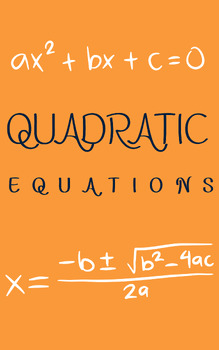MASTERING THE ART OF SOLVING Quadratic Equations
- PDF
- Easel Assessment
Description
Quadratic Equations and Functions
Course Description:
Course Overview: Quadratic Equations and Functions is a fundamental course in algebra that explores the properties, applications, and graphical representations of quadratic equations and quadratic functions. This course is designed to provide students with a solid understanding of the mathematical principles underlying quadratic relationships, equipping them with essential problem-solving skills and critical thinking abilities. Students will learn to solve quadratic equations using various methods, graph quadratic functions, and apply these concepts to real-world scenarios.
Key Topics and Learning Objectives:
- Fundamentals of Quadratic Equations:
- Understand the structure of quadratic equations and their key components.
- Identify the coefficients, constants, and variables within a quadratic equation.
- Solving Quadratic Equations:
- Learn various methods for solving quadratic equations, including factoring, completing the square, and using the quadratic formula.
- Apply problem-solving techniques to analyze and solve real-world problems modeled by quadratic equations.
- The Discriminant and Nature of Roots:
- Explore the concept of the discriminant (Δ) and its role in classifying the nature of solutions (real, repeated, complex) to quadratic equations.
- Use the discriminant to make predictions about the behavior of quadratic equations.
- Graphing Quadratic Functions:
- Graph quadratic functions and understand their fundamental shape, the parabola.
- Identify and interpret key features of the graph, including the vertex, axis of symmetry, y-intercept, and x-intercepts.
- Transformations of Quadratic Functions:
- Analyze how changes in the coefficients of quadratic functions affect the position, orientation, and size of the corresponding parabolas.
- Explore the concept of transformations and their graphical representations.
- Applications of Quadratic Equations and Functions:
- Apply quadratic equations and functions to model and solve real-world problems in fields such as physics, engineering, finance, and biology.
- Develop critical thinking skills in identifying mathematical models for various scenarios.
Assessment and Evaluation:
Students will be assessed through a combination of methods, including quizzes, homework assignments, projects, and examinations. Assessments will measure students' ability to solve quadratic equations, graph quadratic functions, and apply their knowledge to practical situations.
Prerequisites:
Completion of a course in Algebra 1 or equivalent foundational algebraic knowledge is recommended as a prerequisite for this course.
Course Materials:
Textbooks, graphing calculators, and graphing software may be used as instructional materials. Access to technology for graphing and visualization is encouraged.
Course Benefits:
By the end of this course, students will have a strong grasp of quadratic equations and functions, enabling them to confidently solve problems, analyze data, and make informed decisions in various academic and real-life contexts. This foundational knowledge is essential for future studies in mathematics, science, engineering, and related fields.
Course Credit:
This course typically earns students one high school credit upon successful completion.



